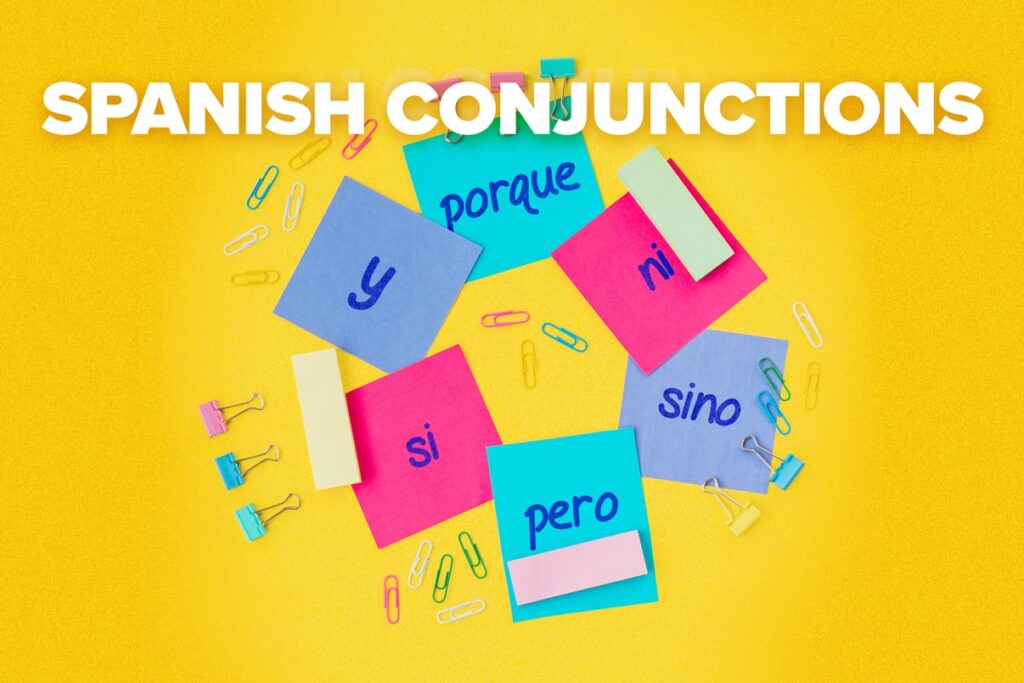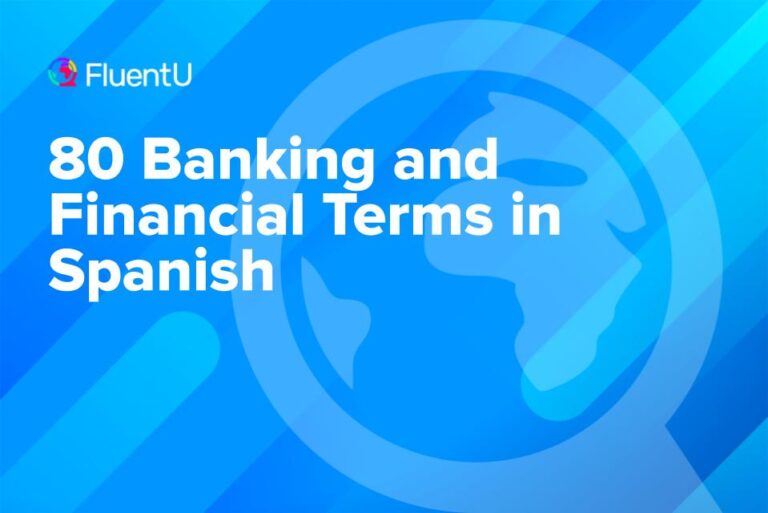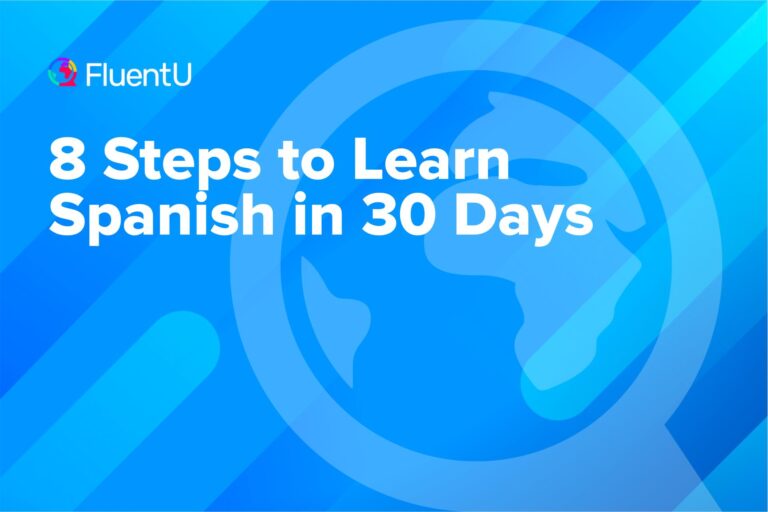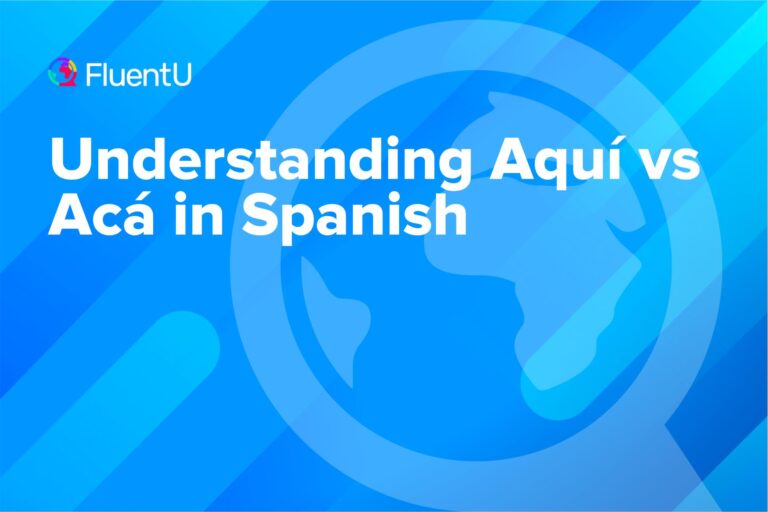45 Spanish Conjunctions for Naturally Flowing Sentences

If you’re learning Spanish, you’ve undoubtedly heard numerous Spanish conjunctions in use. These words and phrases can help you step up your language by connecting your thoughts and information into more complex sentences. They make your speaking and writing sound more natural and flow more easily.
In this article, you’ll learn 45 different Spanish conjunctions and how to use them so you can maneuver the language with confidence.
Download: This blog post is available as a convenient and portable PDF that you can take anywhere. Click here to get a copy. (Download)
What Are Spanish Conjunctions?
Simply put, Spanish conjunctions are invariable parts of speech that are used to connect words, phrases or clauses within a sentence.
They enable the smooth flow of ideas and express relationships between different elements. Conjunctions play a crucial role in structuring sentences and conveying various meanings in Spanish.
Spanish distinguishes two main types of conjunctions: coordinating (coordinantes) and subordinating (subordinates). Each of these types includes different categories. In the following sections, you’ll learn the most commonly used Spanish conjunctions in each category.
Learn more about conjunctions by reading through this post, then finding examples in context in FluentU videos.
FluentU takes authentic videos—like music videos, movie trailers, news and inspiring talks—and turns them into personalized language learning lessons.
You can try FluentU for free for 2 weeks. Check out the website or download the iOS app or Android app.
P.S. Click here to take advantage of our current sale! (Expires at the end of this month)

Coordinating Conjunctions
Coordinating conjunctions in Spanish are words used to connect words, phrases or independent clauses of equal grammatical importance within a sentence. They serve to join elements that have similar functions or roles.
If two or more words are joined by a coordinating conjunction, they must belong to the same part of speech (for example, two nouns or two verbs). The following sections will cover the four main subgroups of coordinating conjunctions.
Conjunctions that express an addition
The first subgroup of coordinating conjunctions is used to add options together. The options can range from two or more words to two or more clauses or even whole sentences.
| Conjunction | Usage | Examples |
|---|---|---|
| y (and) | Allows you to put together 2 or more words, clauses or sentences, including all of them in the same group at the same time. | Me gustan el amarillo y el azul.
(I like the yellow and blue ones.) Antonio hizo la compra y preparó el almuerzo. (Antonio went grocery shopping and prepared lunch.) El abogado me pidió el DNI, anotó mis datos y me dijo que me llamaría. (The lawyer asked me for my ID, wrote down my personal details and told me he'd call me.) |
| e (and) | Used instead of y when the word that follows the conjunction starts with an i (ee) sound.* | Juan e Isa se acaban de casar.
(Juan and Isa have just gotten married.) Me levanté e hice la cama. (I got up and made the bed.) Luis es alto, guapo e inteligente. (Luis is tall, handsome and intelligent.) |
| ni
(neither) ni...ni (neither...nor) | Used to express negation or to join 2 or more negative elements in a sentence. Can be used alone or in pairs to add more emphasis. | No me gusta la carne ni el pescado.
(I don't like meat or fish.) No tengo ni tiempo ni dinero para ir de vacaciones este año. (I have neither time nor money to go on vacation this year.) Ni España ni Portugal tienen más de 100 millones de habitantes. (Neither Spain nor Portugal has more than 100 million inhabitants.) |
*If the word following the conjunction starts with a diphthong (ia/hia, ie/hie, io/hio), we use y as usual.
Hay agua y hielo en la mesa. (There’s water and ice on the table.)
Pela las patatas y hiérvelas. (Peel the potatoes and boil them.)
Conjunctions that offer alternatives
This group of conjunctions allows you to choose among different options or alternatives. These conjunctions are exclusive because they express the fact that you can’t have more than one of the options and will need to choose one.
| Conjunction | Usage | Examples |
|---|---|---|
| o (or) | Used when you need to choose 1 from 2 or more alternatives. | ¿Quieres café o té?
(Do you want coffee or tea?) Quizás es profesor, juez o médico. (He may be a professor, a judge or a doctor.) Volvió a las 3 o las 4 de la mañana. (He came back at 3 or 4 a.m.) |
| u (or) | Used instead of o if the word that follows the conjunction starts with an o (oh) sound. | Tendrá siete u ocho años.
(He must be seven or eight years old.) Elige uno u otro. (Choose one or the other.) Pídele a tu hermano 10 u 11 euros. (Ask your brother for 10 or 11 euros.) |
| o...o (either...or) | Used when there are only 2 options. | O compras una casa pequeña o ahorras un poco más para poder comprar una más grande.
(Either you buy a small house or you save up a little more so you can buy a bigger one.) Puedes elegir o el blanco o el negro. (You can choose either the white one or the black one.) Solo puedo comprar o plátanos o manzanas. No tengo mucho dinero. (I can only buy either bananas or apples. I don't have a lot of money.) |
Conjunctions that give an explanation
The third group of conjunctions is very easy to use. It allows you to add information or an explanation to what you’ve just said. There are two conjunctions in this group:
| Conjunction | Usage | Examples |
|---|---|---|
| esto es (that is to say, in other words, i.e.) | Used to explain or clarify what you've just said. This conjunction is a bit formal and should always be written between commas. | He comprado la mitad, esto es, cinco piezas.
(I've bought half of it, i.e., five pieces.) El hombre giró en dirección sur, esto es, giró a la derecha. (The man turned South, in other words, he turned right.) Tenemos la colección entera, esto es, las 57 tazas. (We have the whole collection, that is, all 57 mugs.) |
| es decir (that is to say, in other words, i.e.) | Means the same as esto es but is much more commonly used. Should always be written between commas. | Hay 250 personas más que en 2007, es decir, ha habido un aumento del 23% en 11 años.
(There are 250 more people than in 2007, i.e., there's been an increment of 23% in 11 years.) He dejado mi trabajo, es decir, estoy en paro. (I've quit my job, in other words, I'm unemployed.) Soy hijo único, es decir, no tengo hermanos ni hermanas. (I'm an only child, in other words, I don't have any brothers or sisters.) |
Conjunctions that express contrast
These conjunctions are used to express contrast or opposition between what’s been said and what’s going to be said. This group of conjunctions has many entries, so I’ve chosen the ones that we often use in our daily lives.
| Conjunction | Usage | Examples |
|---|---|---|
| aunque (although, though, even though, even if) | Very commonly used to express a contradiction or something that goes against the expectation. | Ya he almorzado aunque solo son las 11 de la mañana.
(I've already eaten lunch even though it's only 11 a.m.) Aunque hace frío, vamos a pasear al parque. (Even though it's cold, we're going for a walk in the park.) |
| pero (but, yet) | Can be used to indicate contradiction or emphasis. | Es bajo pero es un buen jugador de baloncesto.
(He's short, but he's a good basketball player.) El coche es pequeño pero bonito. (The car is small yet beautiful.) |
| mas (but, yet) | The very formal counterpart to pero. Notice the lack of accent mark, as opposed to más (more). | Tengo dinero, mas no soy rico.
(I have money, but I'm not rich.) Le envió una carta, mas él nunca contestó. (She sent him a letter, but he never answered back.) |
| sino (but) | Normally used when the previous part of the sentence is negative (no...sino). | No es febrero sino marzo.
(It's not February but March.) No hemos comprado una casa sino un piso. (We haven't bought a house but an apartment.) |
| no obstante (however, nevertheless) | Rather formal and is normally used after a period and before a comma. | Me gusta viajar. No obstante, nunca he estado en España.
(I like traveling. However, I've never been to Spain.) Me mintió. No obstante, lo perdoné. (He lied to me. However, I forgave him.) |
| sin embargo (however, nevertheless, though) | Less formal than no obstante. It can be written between a semicolon and a comma or between a period and a comma. | Soy estudiante. Sin embargo, ya tengo trabajo.
(I'm a student. However, I already have a job.) Está lloviendo; sin embargo, voy a salir a correr. (It's raining. However, I'm going to go for a run.) |
Subordinating Conjunctions
Subordinating conjunctions are words or phrases that introduce dependent or subordinate clauses within a sentence. These conjunctions create a relationship of dependence between the subordinate clause and the main clause, indicating that the action or idea in the subordinate clause relies on the main clause to convey its meaning.
The following sections will cover the five main subgroups of subordinating conjunctions.
Conjunctions that express purpose
These conjunctions are used to say that something has happened/been done so that something else can happen/be done.
They all mean the same and are used for the same purpose. The verb used after these conjunctions is in the subjunctive form since there’s some doubt or uncertainty that the action will occur.
| Conjunction | Usage | Examples |
|---|---|---|
| para que (so that, so, in order to/for) | The most common, least formal conjunction of the group. | He apagado las luces para que puedas dormir.
(I've switched the lights off so that you can sleep.) Te lo doy para que seas feliz. (I'm giving it to you so that you are happy.) |
| a fin de que (so that, so, in order to/for) | This one's more formal than para que. | A fin de que los españoles dejen de fumar, vamos a crear una nueva ley.
(In order for Spanish people to stop smoking, we're going to create a new law.) Quiero decirte la verdad a fin de que puedas perdonarme algún día. (I want to tell you the truth so that you can forgive me one day.) |
| con el fin de que (so that, so, in order to) | This is another formal version of the conjunction. | He solicitado un préstamo con el fin de que compres una casa.
(I've applied for a loan so that you can buy a house.) Hemos creado un nuevo sistema con el fin de que nuestros trabajadores puedan tener más tiempo libre. (We've created a new system so that our workers can have more free time.) |
| con el objeto de que (so that, so, in order to) | Means the same and is used the same as con el fin de que but is even more formal. | Estoy estudiando mucho con el objeto de que apruebe el examen.
(I am studying a lot in order to pass the exam.) Prepararon un plan detallado con el objeto de que el proyecto sea un éxito. (They prepared a detailed plan with the purpose of making the project a success.) |
Conjunctions that give a reason
This group of conjunctions introduces a clause that explains the reason why something has happened, can happen, will happen, etc. It’s a very crowded group, but here are its main members:
| Conjunction | Usage | Examples |
|---|---|---|
| por (for, because of, due to) | Used to introduce a cause or reason for an action or event. It's followed by a noun, infinitive verb or perfect infinitive verb, never a conjugated verb (when used as a conjunction). | Cancelaron el concierto por la tormenta.
(They canceled the concert because of the storm.) Me gritó por romper un plato. (He yelled at me for breaking a plate.) Por haber estudiado mucho, aprobé el examen con facilidad. (Because I had studied a lot, I passed the exam easily.) |
| porque (because) | Mainly used to answer por qué (why) questions. | No voy a la fiesta porque estoy enfermo.
(I'm not going to the party because I'm ill.) ¿Por qué? Porque yo lo digo. (Why? Because I say so.) |
| ya que / puesto que / en vista de que (since, because) | These all mean the same, can be used interchangeably and are somewhat formal. | No he comprado el teléfono, ya que no tengo dinero.
(I haven't bought the phone because I don't have any money.) Puesto que está lloviendo, no iremos al cine. (Since it's raining, we won't go to the cinema.) En vista de que no has aprobado tus exámenes, no puedes ir de vacaciones. (Since you haven't passed your exams, you can't go on vacation.) |
| pues (because, since, for, then, well) | Used to express cause, motive or reason. It can also show sequential value, a question or to emphasize the phrase. | Hemos decidido vender la casa, pues queremos mudarnos a Polonia.
(We've decided to sell the house because we want to move to Poland.) El suelo estaba mojado, pues Juan había estado regando las plantas. (The floor was wet, since Juan had been watering the plants.) |
| como (because, since, as, if) | When used to mean "since" and then give a reason, it's always the first word in the sentence. | Como estaba nevando, decidimos quedarnos en casa.
(Since it was snowing, we decided to stay home.) Como no me desperté, me perdí el desayuno. (Since I didn't wake up, I missed breakfast.) |
| que (because, or else) | Used in informal situations. It also normally has the connotation of a warning or hidden advice. | Deja de correr que te vas a caer.
(Stop running, or else you'll fall.) Ven, que necesito ayuda. (Come, because I need help.) |
Conjunctions that express a condition
This group of conjunctions is quite self-explanatory. Use these conjunctions when you want to describe a condition. In other words, one clause depends on the other to become possible.
| Conjunction | Usage | Examples |
|---|---|---|
| si (if) | Mostly used to introduce a condition. | Si vas a la tienda, compra tomates.
(If you go to the grocery store, buy tomatoes.) No te compraré un ordenador si no apruebas todos tus exámenes. (I won't buy you a computer if you don't pass all your exams.) |
| como
(if) | Yet another como conjunction with a different meaning! Used when you want to warn or threaten someone. The verb following como is in the subjunctive form. | Como no vengas, no compraré helado.
(If you don't come, I won't buy ice cream.) No irás a la fiesta como no te portes bien. (You won't go to the party if you don't behave.) |
| siempre que
(provided, if, as long as) | Also followed by the subjunctive form to express doubt or uncertainty. | Puedes jugar siempre que termines tus deberes.
(You can play provided you finish your homework.) Siempre que digas la verdad, te perdonaré. (If you tell the truth, I'll forgive you.) |
| mientras que (provided, as long as, if) | This is used in the same way as siempre que and is also followed by the subjunctive. | Mientras que estudies con dedicación, aprobarás el examen.
(As long as you study with dedication, you'll pass the exam.) Mientras que sigas las instrucciones, no tendrás problemas con el proyecto. (As long as you follow the instructions, you won't have any issues with the project.) |
| con tal de que / a condición de que (provided that, on condition that) | Both of these conjunctions are also followed by the subjunctive form. | Lo acepto con tal de que me paguen más.
(I'll accept that on condition that they pay me more.) Te lo presto a condición de que me lo devuelvas antes del lunes. (I'll lend it to you on condition that you give it back to me before Monday.) |
| en caso de que (if) | A more formal version of si. It's normally used at the beginning of sentences and, again, is followed by the subjunctive form. | En caso de que decidas venir, compra vino.
(If you decide to come, buy some wine.) En caso de que llegues tarde, no podrás entrar. (If you arrive late, you won't be able to come in.) |
Conjunctions that express a result
This group of conjunctions is used when you want to state the results or consequences of what’s been said or done before. The main conjunctions in this group are:
| Conjunction | Usage | Examples |
|---|---|---|
| así que (so) | Normally follows a comma or a period. | Llegué tarde, así que no pude entrar.
(I arrived late, so I wasn't able to go in.) Estoy muy cansado, así que me voy a dormir. (I'm very tired, so I'm going to sleep.) |
| luego
(so) | Means the same as así que and is used in the same way, but is less common. | No tengo dinero, luego no puedo comprar una casa.
(I don't have any money, so I can't buy a house.) Yo también estaba aquí, luego no tienes que repetir la historia. (I was also here, so you don't have to repeat the story.) |
| de modo que
(so, so that) | Followed by the subjunctive when there's doubt or uncertainty that the action will happen. | Termina rápido, de modo que podamos irnos ya.
(Finish quickly so we can go already.) No estaba cansado, de modo que me fui a correr. (I wasn't tired, so I went for a run.) |
| por lo tanto / por lo consiguiente (therefore, consequently) | These are rather formal, especially por consiguiente. They're always followed by a comma. | Solo hablo español, por lo tanto, no hablo japonés.
(I only speak Spanish. Therefore, I don't speak Japanese.) Hay mucha pobreza en España. Por consiguiente, se deben hacer cambios. (There's a lot of poverty in Spain, therefore, changes need to be made.) |
Conjunctions that express time
Conjunctions of time are used to say when something happened, happens or will happen. In most cases, when the action described is anticipated or hypothetical, the subjunctive mood is used.
In other words, if the verb after these conjunctions hasn’t happened yet, it should be in the subjunctive.
| Conjunction | Usage | Examples |
|---|---|---|
| antes (de) que
(before) | Used to express "before doing something." Always followed by the subjunctive. | Antes de que te vayas, ¿me puedes ayudar con algo?
(Before you leave, can you help me with something?) Tenemos que comprar los ingredientes antes de que cierre la tienda. (We have to buy the ingredients before the store closes.) |
| después (de) que (after) | Used to express "after doing something." Uses the indicative when referring to a present event, the indicative or the subjunctive when referring to a past event and the subjunctive when referring to a future event. | Después de que Sara termina de trabajar los viernes, nos reunimos para cenar. (After Sara finishes work on Fridays, we meet up for dinner.) Llegó 10 minutos después de que comenzara la película. (She arrived 10 minutes after the movie started.) Llámame después de que termines de trabajar. (Call me after you finish working.) |
| cuando
(when) | Followed by the indicative mood when followed by an action that has happened or happens in general and the subjunctive when the action hasn't been completed yet. | Siempre me pongo triste cuando llueve.
(I always feel sad when it rains.) Nos encontraremos en el parque cuando salgas de la reunión. (We'll meet at the park when you leave the meeting.) |
| mientras (while) | Can be used to express that 2 actions are done at the same time. In this case, we use the indicative form of the verb even if the action hasn't happened yet. | Estudié para el examen mientras él cocinaba la cena.
(I studied for the exam while he cooked dinner.) Mientras esperamos el tren, podemos charlar un rato. (While we wait for the train, we can chat for a while.) |
| en cuanto / tan pronto como (as soon as) | These conjunctions are always followed by the subjunctive, unless they're used in the past tense for something that already happened. | Te llamaré en cuanto llegue a casa.
(I'll call you as soon as I get home). Tan pronto como termines tus deberes, podemos ir al parque. (As soon as you finish your homework, we can go to the park.) |
| hasta que (until) | Hasta que is used before a verb to express the notion of "until" or "up to the point when" in relation to time or conditions. | Me quedaré en la playa hasta que oscurezca.
(I'm going to stay at the beach until it gets dark.) Espérame aquí hasta que vuelva. (Wait for me here until I come back.) |
Remember that conjunctions are only words that can help us improve our language skills. Don’t try to avoid them, especially if you want to be an advanced Spanish user.
The more often you use them in your Spanish writing and conversations, the better. Practice a few every day and you’ll soon feel more confident using many of these Spanish conjunctions!
Download: This blog post is available as a convenient and portable PDF that you can take anywhere. Click here to get a copy. (Download)
And One More Thing…
If you've made it this far that means you probably enjoy learning Spanish with engaging material and will then love FluentU.
Other sites use scripted content. FluentU uses a natural approach that helps you ease into the Spanish language and culture over time. You’ll learn Spanish as it’s actually spoken by real people.
FluentU has a wide variety of videos, as you can see here:

FluentU brings native videos within reach with interactive transcripts. You can tap on any word to look it up instantly. Every definition has examples that have been written to help you understand how the word is used. If you see an interesting word you don’t know, you can add it to a vocab list.

Review a complete interactive transcript under the Dialogue tab, and find words and phrases listed under Vocab.

Learn all the vocabulary in any video with FluentU’s robust learning engine. Swipe left or right to see more examples of the word you’re on.

The best part is that FluentU keeps track of the vocabulary that you’re learning, and gives you extra practice with difficult words. It'll even remind you when it’s time to review what you’ve learned. Every learner has a truly personalized experience, even if they’re learning with the same video.
Start using the FluentU website on your computer or tablet or, better yet, download the FluentU app from the iTunes or Google Play store. Click here to take advantage of our current sale! (Expires at the end of this month.)







